
Mouse Anti-C-erbB-2/HER2 antibody
Erb-B2 Receptor Tyrosine Kinase 2; HER2; NGL; NEU; V-Erb-B2 Avian Erythroblastic Leukemia Viral Oncogene Homolog 2; Tyrosine Kinase-Type Cell Surface Receptor HER2; Neuro/Glioblastoma Derived Oncogene Homolog; Human Epidermal Growth Factor Receptor 2; Met
View History [Clear]
Details
Product Name C-erbB-2/HER2 Chinese Name HER2单克隆抗体 Alias Erb-B2 Receptor Tyrosine Kinase 2; HER2; NGL; NEU; V-Erb-B2 Avian Erythroblastic Leukemia Viral Oncogene Homolog 2; Tyrosine Kinase-Type Cell Surface Receptor HER2; Neuro/Glioblastoma Derived Oncogene Homolog; Human Epidermal Growth Factor Receptor 2; Metastatic Lymph Node Gene 19 Protein; Proto-Oncogene C-ErbB-2; Proto-Oncogene Neu; EC 2.7.10.1; P185erbB2; MLN 19; V-Erb-B2 Avian Erythroblastic Leukemia Viral Oncogene Homolog 2; V-Erb-B2 Erythroblastic Leukemia Viral Oncogene Homolog 2, Neuro/Glioblastoma Derived Oncogene Homolog; V-Erb-B2 Avian Erythroblastic Leukemia Viral Oncoprotein 2; Neuroblastoma/Glioblastoma Derived Oncogene Homolog; Receptor Tyrosine-Protein Kinase ErbB-2; C-Erb B2/Neu Protein; CD340 Antigen; Herstatin; EC 2.7.10; CD340; HER-2; MLN19; TKR1; literatures Research Area Tumour immunology Signal transduction Kinases and Phosphatases Immunogen Species Mouse Clonality Monoclonal Clone NO. 13H9 React Species Human, (predicted: Mouse, Rat, ) Applications WB=1:500-1000 IHC-P=1:100-500 IHC-F=1:100-500 IF=1:100-500 (Paraffin sections need antigen repair)
not yet tested in other applications.
optimal dilutions/concentrations should be determined by the end user.Theoretical molecular weight 138kDa Cellular localization The nucleus cytoplasmic The cell membrane Form Liquid Concentration 1mg/ml immunogen Recombinant human HER2 protein: full length Lsotype IgG Purification affinity purified by Protein G Buffer Solution 0.01M TBS(pH7.4) with 1% BSA, 0.03% Proclin300 and 50% Glycerol. Storage Shipped at 4℃. Store at -20 °C for one year. Avoid repeated freeze/thaw cycles. Attention This product as supplied is intended for research use only, not for use in human, therapeutic or diagnostic applications. PubMed PubMed Product Detail This gene encodes a member of the epidermal growth factor (EGF) receptor family of receptor tyrosine kinases. This protein has no ligand binding domain of its own and therefore cannot bind growth factors. However, it does bind tightly to other ligand-bound EGF receptor family members to form a heterodimer, stabilizing ligand binding and enhancing kinase-mediated activation of downstream signalling pathways, such as those involving mitogen-activated protein kinase and phosphatidylinositol-3 kinase. Allelic variations at amino acid positions 654 and 655 of isoform a (positions 624 and 625 of isoform b) have been reported, with the most common allele, Ile654/Ile655, shown here. Amplification and/or overexpression of this gene has been reported in numerous cancers, including breast and ovarian tumors. Alternative splicing results in several additional transcript variants, some encoding different isoforms and others that have not been fully characterized. [provided by RefSeq, Jul 2008].
Function:
Protein tyrosine kinase that is part of several cell surface receptor complexes, but that apparently needs a coreceptor for ligand binding. Essential component of a neuregulin-receptor complex, although neuregulins do not interact with it alone. GP30 is a potential ligand for this receptor. Regulates outgrowth and stabilization of peripheral microtubules (MTs). Upon ERBB2 activation, the MEMO1-RHOA-DIAPH1 signaling pathway elicits the phosphorylation and thus the inhibition of GSK3B at cell membrane. This prevents the phosphorylation of APC and CLASP2, allowing its association with the cell membrane. In turn, membrane-bound APC allows the localization of MACF1 to the cell membrane, which is required for microtubule capture and stabilization.
In the nucleus is involved in transcriptional regulation. Associates with the 5'-TCAAATTC-3' sequence in the PTGS2/COX-2 promoter and activates its transcription. Implicated in transcriptional activation of CDKN1A; the function involves STAT3 and SRC. Involved in the transcription of rRNA genes by RNA Pol I and enhances protein synthesis and cell growth.
Subunit:
Homodimer. Heterodimer with EGFR, ERBB3 and ERBB4. Part of a complex with EGFR and either PIK3C2A or PIK3C2B. May interact with PIK3C2B when phosphorylated on Tyr-1196. Interacts with PRKCABP and PLXNB1. Interacts (when phosphorylated on Tyr-1248) with MEMO1. Interacts with MUC1; the interaction is enhanced by heregulin (HRG). Interacts (when phosphorylated on Tyr-1139) with GRB7 (via SH2 domain). Interacts (when phosphorylated on Tyr-1248) with ERBB2IP. Interacts with KPNB1, RANBP2, EEA1, CRM1, CLTC, PTK6, RPA94 and ACTB. Interacts with SRC.
Subcellular Location:
Isoform 1: Cell membrane; Single-pass type I membrane protein. Cytoplasm, perinuclear region. Nucleus.
Isoform 2: Cytoplasm. Nucleus.
Isoform 3: Cytoplasm. Nucleus.
Tissue Specificity:
Expressed in a variety of tumor tissues including primary breast tumors and tumors from small bowel, esophagus, kidney and mouth.
Post-translational modifications:
Autophosphorylated. Ligand-binding increases phosphorylation on tyrosine residues. Autophosphorylation occurs in trans, i.e. one subunit of the dimeric receptor phosphorylates tyrosine residues on the other subunit. Signaling via SEMA4C promotes phosphorylation at Tyr-1248.
DISEASE:
Defects in ERBB2 are a cause of hereditary diffuse gastric cancer (HDGC) [MIM:137215]. A cancer predisposition syndrome with increased susceptibility to diffuse gastric cancer. Diffuse gastric cancer is a malignant disease characterized by poorly differentiated infiltrating lesions resulting in thickening of the stomach. Malignant tumors start in the stomach, can spread to the esophagus or the small intestine, and can extend through the stomach wall to nearby lymph nodes and organs. It also can metastasize to other parts of the body.
Defects in ERBB2 are involved in the development of glioma (GLM) [MIM:137800]. Gliomas are central nervous system neoplasms derived from glial cells and comprise astrocytomas, glioblastoma multiforme, oligodendrogliomas, and ependymomas.
Defects in ERBB2 are a cause of susceptibility to ovarian cancer (OC) [MIM:167000]. Ovarian cancer common malignancy originating from ovarian tissue. Although many histologic types of ovarian neoplasms have been described, epithelial ovarian carcinoma is the most common form. Ovarian cancers are often asymptomatic and the recognized signs and symptoms, even of late-stage disease, are vague. Consequently, most patients are diagnosed with advanced disease.
Defects in ERBB2 may be a cause of lung cancer (LNCR) [MIM:211980]. LNCR is a common malignancy affecting tissues of the lung. The most common form of lung cancer is non-small cell lung cancer (NSCLC) that can be divided into 3 major histologic subtypes: squamous cell carcinoma, adenocarcinoma, and large cell lung cancer. NSCLC is often diagnosed at an advanced stage and has a poor prognosis.
Defects in ERBB2 are a cause of gastric cancer (GASC) [MIM:613659]. A malignant disease which starts in the stomach, can spread to the esophagus or the small intestine, and can extend through the stomach wall to nearby lymph nodes and organs. It also can metastasize to other parts of the body. The term gastric cancer or gastric carcinoma refers to adenocarcinoma of the stomach that accounts for most of all gastric malignant tumors. Two main histologic types are recognized, diffuse type and intestinal type carcinomas. Diffuse tumors are poorly differentiated infiltrating lesions resulting in thickening of the stomach. In contrast, intestinal tumors are usually exophytic, often ulcerating, and associated with intestinal metaplasia of the stomach, most often observed in sporadic disease.
Note=Chromosomal aberrations involving ERBB2 may be a cause gastric cancer. Deletions within 17q12 region producing fusion transcripts with CDK12, leading to CDK12-ERBB2 fusion leading to trunctated CDK12 protein not in-frame with ERBB2.
Similarity:
Belongs to the protein kinase superfamily. Tyr protein kinase family. EGF receptor subfamily.
Contains 1 protein kinase domain.
SWISS:
P04626
Gene ID:
2064
Database links:Entrez Gene: 2064 Human
Entrez Gene: 13866 Mouse
Omim: 164870 Human
SwissProt: P04626 Human
SwissProt: P70424 Mouse
Unigene: 446352 Human
Unigene: 290822 Mouse
Unigene: 93966 Rat
Product Picture
Lane 1: Human A431 cell lysates
Lane 2: Human LOVO cell lysates
Lane 3: Human HeLa cell lysates
Primary: Anti-C-erbB-2/HER2 (SLM-33051M) at 1/200 dilution
Secondary: IRDye800CW Goat Anti-Mouse IgG at 1/20000 dilution
Predicted band size: 138 kDa
Observed band size: 180 kDa
Sample:
Lane 1: A431 (Human) Cell Lysate at 30 ug
Lane 2: SW480 (Human) Cell Lysate at 30 ug
Lane 3: Siha (Human) Cell Lysate at 30 ug
Lane 4: A549 (Human) Cell Lysate at 30 ug
Primary: Anti-C-erbB-2/HER2 (SLM-33051M) at 1/1000 dilution
Secondary: IRDye800CW Goat Anti-Mouse IgG at 1/20000 dilution
Predicted band size: 185/100-110 kD
Observed band size: 185 kD
Paraformaldehyde-fixed, paraffin embedded (Human breast carcinoma); Antigen retrieval by boiling in sodium citrate buffer (pH6.0) for 15min; Block endogenous peroxidase by 3% hydrogen peroxide for 20 minutes; Blocking buffer (normal goat serum) at 37°C for 30min; Antibody incubation with (C-erbB-2/HER2) Monoclonal Antibody, conjugated (SLM-33051M) at 1:800 overnight at 4°C, followed by operating according to SP Kit(Mouse) (sp-0024) instructionsand DAB staining.Paraformaldehyde-fixed, paraffin embedded (human colon carcinoma); Antigen retrieval by boiling in sodium citrate buffer (pH6.0) for 15min; Block endogenous peroxidase by 3% hydrogen peroxide for 20 minutes; Blocking buffer (normal goat serum) at 37°C for 30min; Antibody incubation with (C-erbB-2/HER2) Monoclonal Antibody, Unconjugated (SLM-33051M) at 1:200 overnight at 4°C, followed by operating according to SP Kit(Mouse)(sp-0024) instructionsand DAB staining.Paraformaldehyde-fixed, paraffin embedded (Human breast carcinoma); Antigen retrieval by boiling in sodium citrate buffer (pH6.0) for 15min; Block endogenous peroxidase by 3% hydrogen peroxide for 20 minutes; Blocking buffer (normal goat serum) at 37°C for 30min; Antibody incubation with (C-erbB-2,HER2) Monoclonal Antibody, Unconjugated (ascites of SLM-33051M 13H9) at 1:2000 overnight at 4°C, followed by a conjugated secondary (sp-0024) for 20 minutes and DAB staining.
References (0)
No References
Bought notes(bought amounts latest0)
No one bought this product
User Comment(Total0User Comment Num)
- No comment
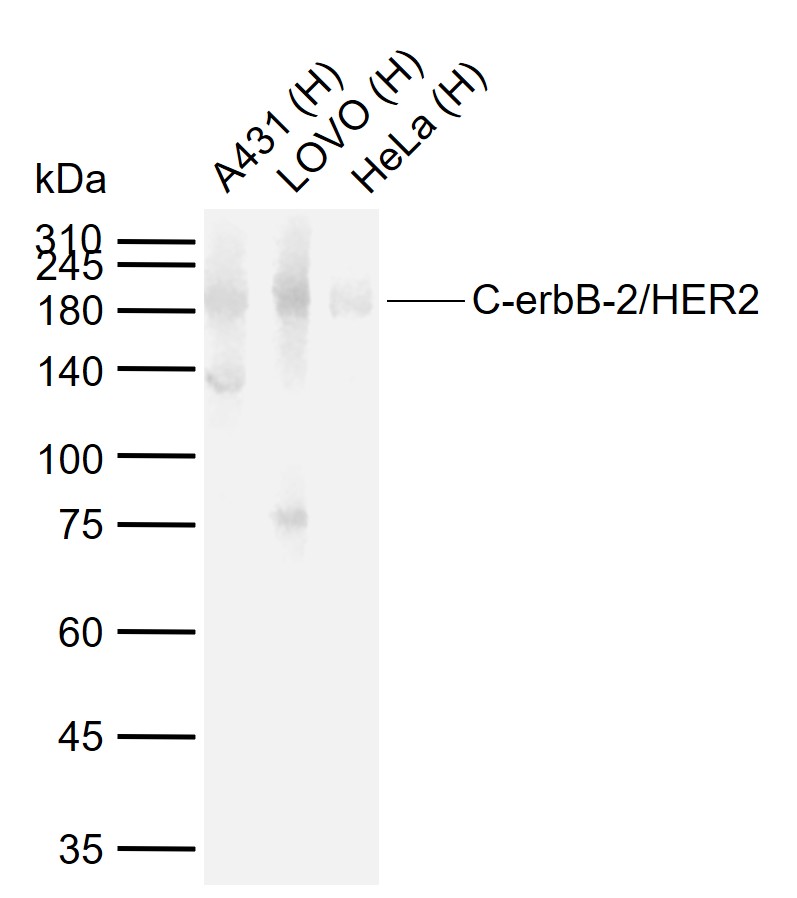
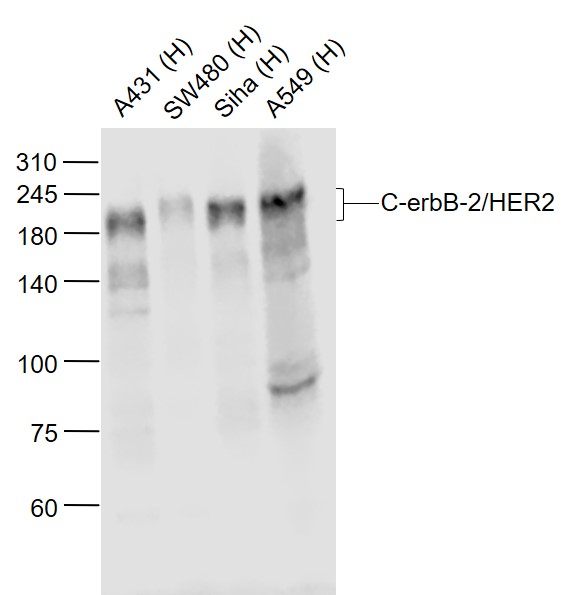
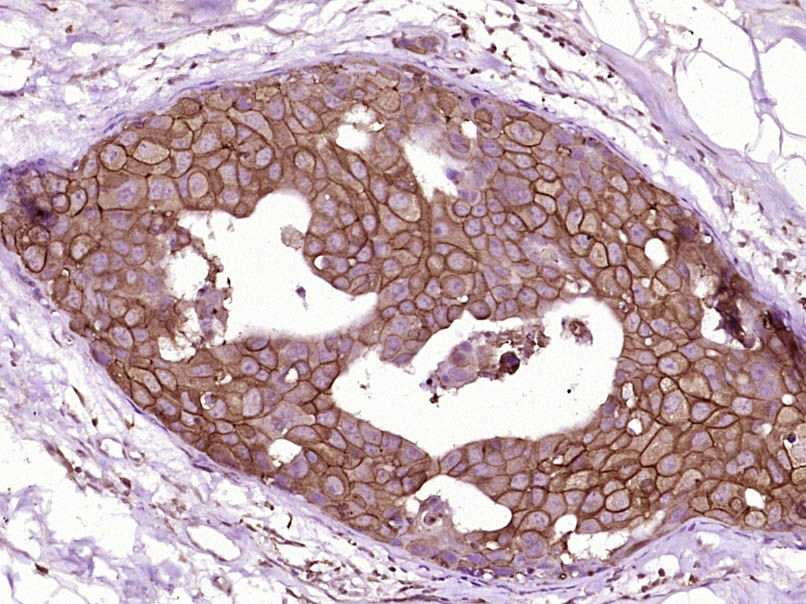
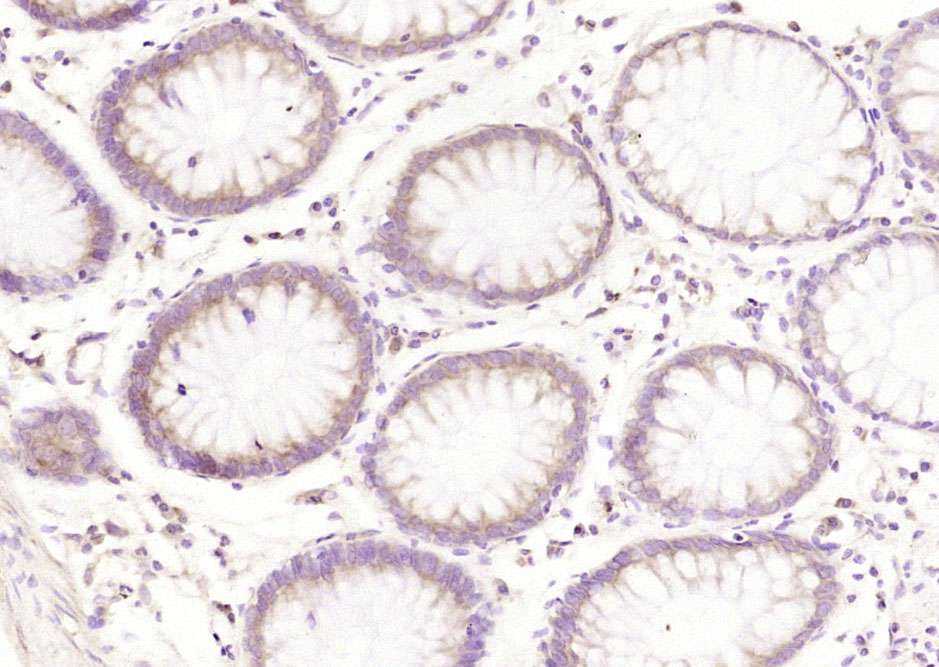
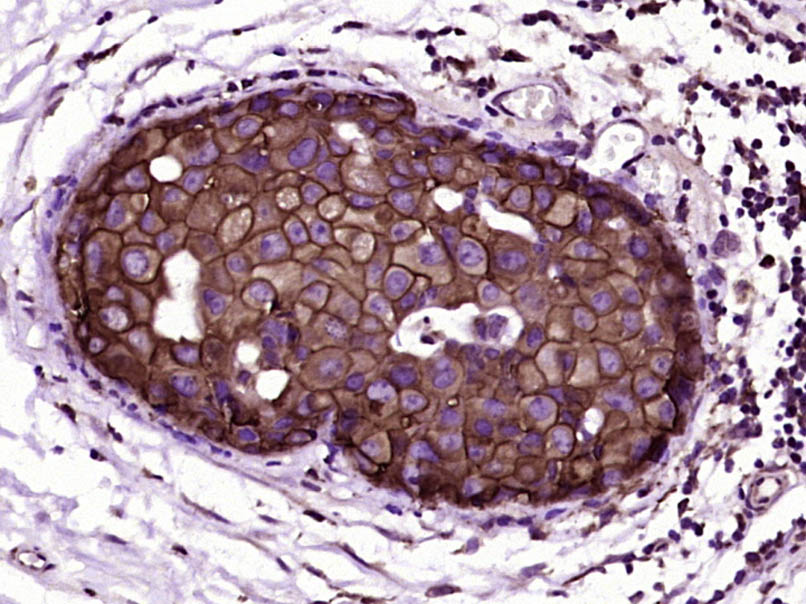


 +86 571 56623320
+86 571 56623320
 +86 18668110335
+86 18668110335

